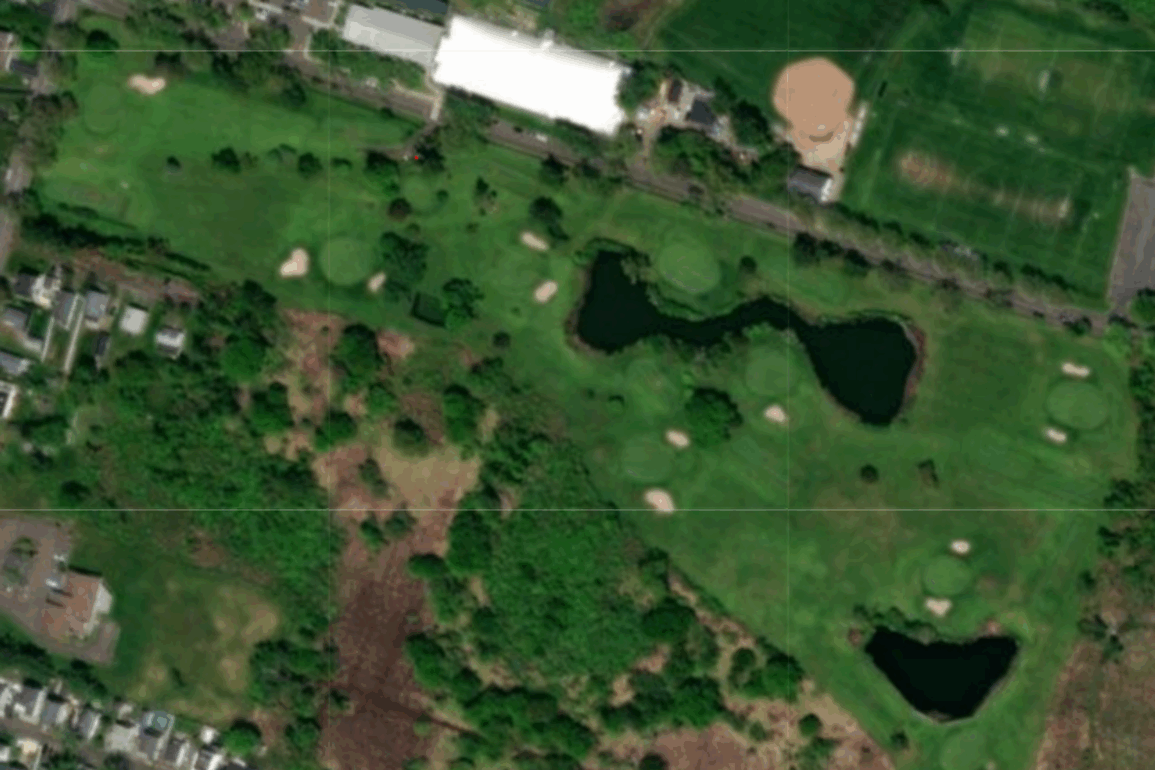Carl Dickman Par 3 is a public 9-hole, 1240-yard municipal course tucked into Fairfield, Connecticut. Designed without pretense but full of purpose, this par-3 layout is a neighborhood institution. Its value lies not in architectural drama but in accessibility and the chance for joyful, meaningful play for all levels—especially families. It’s the kind of place where the final tee time of the day means dad, two kids, and a wedge apiece. Expect a democratic course that gives everyone a chance to swing freely. I still remember making my first-ever birdie on hole 6 here when I was learning the game—just a smooth wedge and a lucky putt. It’s that kind of place.
Walkability
Carl Dickman is a model of walkable design. Nestled into South Pine Creek, its footprint is tight and efficient, with no hole feeling isolated or awkwardly stitched to the next. The longest hole clocks in at 187 yards, and even that sits directly beside the preceding green. Tee-to-green transitions are short and intuitive. The terrain is pancake-flat, giving players of all ages and abilities the confidence to walk it easily. Green-to-tee adjacency helps maintain pace of play, even on busy afternoons.
- Pro: The routing is so tight and rhythmic that walking it feels meditative. Starting with 142 and 144 yard holes at 1 and 2, then gradually stretching out to 165 and 152 at 4 and 5, players are subtly tested while always within reach of the next tee. It’s especially ideal for looping with kids or seniors who can keep up with minimal fatigue. On quiet evenings, the walk between 6 and 9 feels like a slow stroll through a town park.
- Con + Fix: The only walkability issue isn’t terrain or routing—it’s navigation. After finishing hole 4, both the tee boxes for hole 5 and hole 7 are visible from the green. Because hole 7’s tee is more directly in view and aligned with the player’s exit from the green, it’s easy for first-timers to mistakenly walk to 7 instead of doubling back slightly to 5. A modest directional cue, like a small wooden signpost or discreet ground arrow, would smooth this moment of decision and help newer players maintain flow.
Strategic Test
For a par-3 course of this size, Carl Dickman offers more shot variety than you’d expect, though rarely true strategic dilemma. There are no alternate angles or fairway widths to exploit, but players must frequently vary club selection. The hole distances oscillate meaningfully, forcing conscious decision-making between short iron or wedge, and wind plays a meaningful role near the water.
- Pro: Hole 8 is the most cerebral challenge: a 187-yard test where wind swirls unpredictably off the creek and trees shield parts of the approach corridor. Bold players might opt for a hybrid or long iron, aiming for a high draw to hold the putting surface. This route flirts with a steep left drop-off and long carry. More conservative players might lay up short-left and try to run one on, but a subtle upslope can deaden the bounce, leaving a delicate chip. Crosswinds complicate both strategies, making distance control and trajectory paramount. The green is slightly pitched, rewarding well-struck mid-irons but punishing anything long or wide. The hole also subtly narrows at the front, adding pressure to shape the ball precisely. The absence of bunkering might seem lenient, but it instead heightens the mental game—players are left to manage contours and wind without visual aiming aids. Pin positions tucked front-left shrink the margin for error, turning this hole into a psychological gauntlet. It plays especially tough late in the day, when shadows stretch and visibility narrows. This hole encapsulates the most advanced decision-making on the property.
- Con + Fix: Hole 3, just 120 yards with a broad green and zero hazards, feels overly passive. There’s no risk-reward. Adding a small front bunker pinched left would create depth perception challenges and invite a fade or high carry to access back-right flags. A low mound right of the green could redirect slightly errant shots toward short grass, adding nuance.
Playability
Carl Dickman excels as a teaching ground. Nearly every hole allows for a ground or air approach, and there are minimal forced carries or penal rough. Shorter hitters can bunt their way around without being punished, and faster players can complete a full round in under an hour. The short tees are forgiving and flow naturally into the design.
- Pro: Hole 6, just 117 yards, is perfectly tuned for new golfers. Its flat entry, receptive green, and open front allow any high-handicapper to feel successful with a clean contact. Even thinned shots can roll up. It’s also an ideal hole to practice low chips or bump-and-runs, which are rare opportunities on more demanding designs.
- Con + Fix: Hole 4 stretches to 165 yards without much visual depth, and there’s little margin for players who can’t carry that full yardage. It also runs so close to the road that any slight push or shank can send a ball rattling into the tree line or chain-link fence along the right side. Installing a small protective netting or planting a staggered hedge line could buffer safety without making the hole feel walled-in.
Atmosphere
While not naturally grand, the course has a quiet, suburban charm. On late afternoons, golden-hour sun bounces off the surrounding trees, and you can hear kids laughing from the adjacent baseball field. The vibe is calm, friendly, and low-pressure. However, the flat terrain and open sightlines limit immersion. A few holes blend into each other without strong visual differentiation.
- Pro: Hole 9 is the most atmospheric finisher: a 90-yard shot across a narrow pond that dares players to take on the full carry with the clubhouse and parking lot just beyond. For such a short hole, it holds real emotional weight—especially with an audience. That final swing can decide your match or just become a personal triumph as the sun dips and the pond glimmers.
- Con + Fix: Hole 4 and hole 5 blur together in tone and appearance. Both stretch over 150 yards with little in the way of framing or defining features. Adding a low berm or reshaped mound along the right of 5 could distinguish its profile, while a greenside bunker short-left on 4 would further differentiate the hole’s character and shot demand.
Final Word
Carl Dickman is the perfect primer for architectural curiosity. It’s a course that embraces simplicity without sacrificing joy. It invites learning, fosters community, and remains incredibly playable at all skill levels. Compared to other munis like H. Smith Richardson (which offers more strategic elevation shifts) or Fairchild Wheeler (which has more variety and better maintenance), Dickman holds its own thanks to pace, accessibility, and familial charm. It’s where golf becomes habit—and habit becomes love. I adore walking it with my kids at day’s end, when shadows lengthen and nobody’s in a rush.

